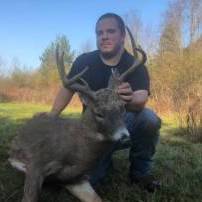NY DEC Issues Guidance To Discourage Black Bear Encounters
-
Similar Content
-
By HuntingNY
All Bonus DMPs Now Antlerless-Only
As a new management tool for deer population control, the State Department of Environmental Conservation (DEC) will issue Bonus Deer Management Permits (DMPs) for antlerless-only this fall, a change from either-sex bonus permits of the past beginning Tuesday, October 1. In an effort to support deer population reduction, Bonus DMPs will be issued in Wildlife Management Units (WMUs) 1C (Suffolk County), 3 S (Westchester County), 4J (eastern Albany County) and 8C (central Monroe County).
Bonus DMPs are issued to increase hunter participation and antlerless deer harvest in areas with abundant deer. They are available to hunters who take an antlerless deer on a regular DMP or a Bonus DMP in one of the four units statewide. No fee is charged for a Bonus DMP. In addition, to streamline the issuance process for the hunter and make it more efficient, Bonus DMP applicants will no longer be required to present a deer head or carcass when applying for a Bonus permit.
"As deer numbers have grown in specific areas in the state, we need another tool to help reduce the population and changing our Bonus Permit program to concentrate on antlerless deer only is the next logical step," said DEC Assistant Commissioner for Natural Resources, Kathleen Moser. "If the change is successful in accomplishing its objective in these areas of the state, antlerless-only Bonus DMPs could expand in the future to additional units. Offering increasing numbers of traditional DMPs (doe permits) each year has not been effective in reducing deer numbers in many of our units, and an expansion of the Bonus Permit system in the future could be a partial solution, as it focuses on successful hunters."
To obtain a Bonus DMP, successful hunters must comply with the following application requirements:
Mail or Electronic Application
Hunters may send, or present in person, clear photocopies, photos, or scanned images of both sides of their completed DMPs or Bonus tags to the appropriate regional DEC office listed below. An original completed WMU DMP carcass tag may be submitted as proof of harvest; however, hunters are reminded that the actual carcass tag must remain affixed to the carcass until it is prepared for consumption (butchered). Although presentation of a deer head or carcass is not required this year for a Bonus DMP as in the past, properly tagged carcasses brought to the location below at the days and times listed will be eligible.
Bonus permits will be processed and sent within two business days. All applicants must include their name, mailing address, and phone number to receive Bonus permits by mail.
More information here: http://www.dec.ny.gov/press/93581.html
This post has been promoted to an article
-
By HuntingNY
Columbus Day weekend, October 6-8, marked the state’s first youth firearms deer hunt and reports from the field indicate the youth deer hunt was a success for many junior hunters as they learned about New York’s rich deer hunting tradition under the watchful eyes of experienced mentors, New York State Department of Environmental Conservation (DEC) Commissioner Joe Martens announced today.
“The youth deer hunt is a great opportunity for the next generation of New York hunters and is an important step in preserving our hunting heritage while maintaining our ability to manage deer through hunting in the future,” said Commissioner Martens. “We received enthusiastic feedback from parents and excited young hunters who took part of the Columbus Day weekend. These experiences demonstrate the great value of providing this unique opportunity for junior hunters.”
During the youth deer hunt, junior hunters (ages 14-15) with a big game hunting license were eligible to take one deer of either sex with a firearm when properly accompanied by a licensed and experienced adult.
The number of Junior Hunting license holders who were eligible to participate at least one day of the youth hunt was 12,753. To date, junior hunters have reported taking 486 deer, though hunters have 7 days to report their kill. DEC anticipates the final harvest estimate for the youth deer hunt will be higher after all reports are in and the harvest is calculated.
DEC Environmental Conservation Officers and wildlife staff were afield throughout the weekend, monitoring hunter activity and talking with bowhunters, small game and turkey hunters, and junior hunters about their experience during the youth deer hunt. Reports from the junior hunters were overwhelmingly positive, and other hunters reported their hunting was not affected by the ongoing youth deer hunt. Some hunters indicated that while they did not support the youth hunt when it was first proposed, their actual observations over the weekend and seeing what a positive experience it was for so many kids, has changed their minds.
Additionally, New York’s junior hunters demonstrated why mentored youth have the greatest safety record of all hunters across the nation; no hunting related shooting incidents were reported during the youth deer hunt.
To showcase the success of junior hunters, DEC encourages parents to submit a picture to DEC’s Big Game Hunting Photo Gallery (www.dec.ny.gov/outdoor/54055.html).
This post has been promoted to an article
-
By HuntingNY
The NY DEC is reporting that the Early Bear season for the Northern Zone is off to a successful start.
Hunters have already reported in over 140 bears for the season that started on September 15th.
Click here to view the article
-
By HuntingNY
DEC ANNOUNCES DETAILS FOR COLUMBUS DAY WEEKEND YOUTH DEER HUNT
The Department of Environmental Conservation (DEC) has confirmed that junior hunters ages 14-15 will be able to hunt deer during a special youth firearms deer season over Columbus Day Weekend this year, October 6 through October 8, 2012.
“Implementation of this youth deer hunt is a hallmark moment for New York hunters and represents continued efforts of DEC to engage more young people in nature and outdoor recreation,” said DEC Commissioner Joe Martens.
The youth deer hunt will take place Columbus Day weekend in both the Northern Zone and Southern Zone; a youth hunt was not established on Long Island due to restrictions in the Environmental Conservation Law. Junior hunters (ages 14-15) with a big game hunting license will be eligible to take one deer of either sex with a firearm when properly accompanied by a licensed and experienced adult. Junior hunters may use a Deer Management Permit or Deer Management Assistance Program tag for an antlerless deer or, during the youth firearms season only, they may use their regular season tag to take a deer of either sex.
In areas restricted to bowhunting only (Westchester County and parts of Albany and Monroe counties), junior hunters may only use bowhunting equipment to take deer during the youth hunt weekend. “Bowhunting seasons remain open during the youth hunt, but I encourage bowhunters to set your bow aside for the weekend and be a mentor for a youth’s first firearms deer hunt,” Commissioner Martens stated.
While there is pending legislation that may impact future youth hunts, until it has been acted on, DEC’s regulations remain in effect. More details of the Youth Firearms Deer Hunt and rules for junior hunters and their mentors are available at www.dec.ny.gov/outdoor/46245.html.
DEC also offers special opportunities for junior hunters (ages 12-15) for waterfowl, wild turkey, and pheasants. See www.dec.ny.gov/outdoor/52495.html for information about these other programs.
This post has been promoted to an article
-
By HuntingNY
The 2012-13 hunting, fishing and trapping licenses and Deer Management Permits (DMPs) may be purchased beginning Monday, August 13, New York State Department of Environmental Conservation (DEC) Commissioner Joe Martens today announced.
“Hunting, trapping and fishing opportunities in New York are fantastic and DEC is committed to helping provide outdoor enthusiasts with numerous recreational opportunities to enjoy the beauty of our state throughout the year,” Commissioner Martens said. “DEC continually works to make improvements to better serve the public and protect our natural resources. Recently, we adopted a new deer management plan, we are developing statewide management plans for black bear and furbearers, and we continue our effort to build and upgrade boat launches.”
Licenses and permits can be purchased at one of DEC’s 1,500 license sales outlets statewide. Sporting licenses can also be ordered by telephone or by visiting the DEC website at http://www.dec.ny.gov/permits/6101.html. The 2012-13 sporting licenses are valid beginning October 1, 2012. The new Hunting & Trapping and Freshwater Fishing regulation guides are available at all license issuing outlets as well as from the DEC website at www.dec.ny.gov.
DEC’s Automated Licensing System (DECALS) is New York State’s computerized system for issuing sporting licenses and tracking license sales and revenues. DECALS may also be used for donations to the Habitat Access Stamp Program, Venison Donation Coalition, Conservation Fund and the Trail Maintenance Program. DEC continues to improve and enhance DECALS to better meet the needs of sportsmen and women. For questions regarding license purchases, please call DECALS Call Center at (1-866-933-2257). Hours of operation for the Call Center are 7 a.m. to 7 p.m., Monday through Saturday from August 13 to October 13, 2012. Regular weekday hours of 8 a.m. to 5 p.m. will resume on October 15, 2012.
License buyers should have the following items ready when applying: complete name and address information, customer ID number if you have it, proof of residency information (driver's license number or non-driver's ID number with a valid NYS address to qualify for a resident license), and, if purchasing by phone or internet, credit card and card expiration date. Hunting license purchases require individuals to provide proof of hunting education certification or a copy of a previous license, or this information must already be contained in their DECALS file.
Sales of all sporting licenses are deposited into the Conservation Fund which is used for the management of New York's fish and wildlife populations and for protection and management of wildlife habitat.
New Regulations for 2012-2013
Hunters should be aware of several new laws and regulations in effect for 2012-13:
· The Southern Zone bowhunting season and the regular season in Westchester County (bowhunting only) begin on October 1.
· A late bowhunting season will run concurrent with the late muzzleloader season in the Northern Zone.
· The Northern Zone regular season will now begin on the 2nd Saturday after Columbus Day each year (October 20, 2012 this season).
Deer Management Permits (DMPs, “doe tags”) may be used in all seasons in the Northern Zone. DMPs may only be used in the Wildlife Management Unit (WMU) for which they are issued.
Mandatory antler restrictions (3 points on one side minimum) are now in effect in WMUs 3A, 4G, 4O, 4P, 4R, 4S, and 4W during all seasons for all hunters 17 years and older.
All of Suffolk County will be open for the special January firearms season, subject to local discharge ordinances.
A Deer Management Focus Area in central Tompkins County will intensify use of hunting to assist communities in the Ithaca area with the burden of overabundant deer populations.
Bear hunting seasons will run concurrently with the newly adjusted deer seasons.
New legislation now allows use of rifles for big game hunting in Cayuga County.
Deer Management Permits
Deer Management Permits (DMPs) will be available at all license issuing outlets and by phone, internet or mail, from August 13, 2012 through close of business October 1, 2012. DMPs are issued through a random selection process at the point of sale, and customers who are selected for DMPs will receive their permits immediately. Chances of selection (http://www.dec.ny.gov/outdoor/30409.html) in each WMU are available at License Issuing Agent locations, or on the DMP Hotline at 1-866-472-4332. Chances of getting a DMP remain the same throughout the application period - hunters do not need to rush to apply for a DMP on the first day of sale.
If a significant number of DMPs are still available in a WMU after October 1, leftover DMP sales will commence on November 1, 2012 and will continue on a first-come/first-serve basis until the end of the hunting season or until all DMPs have been issued in the WMU. Additionally, Bonus DMPs will be available in the bowhunting-only WMUs 3S, 4J, and 8C and in WMUs 1C, 9A and possible others. For information about Bonus DMPs see http://www.dec.ny.gov/outdoor/10001.html.
The target DMP allocation for 2012 varies by unit depending on the management objective, but overall DEC intends to issue about 10 to12 percent more DMPs than in 2011. In addition to the Adirondack and Tug Hill units where DMPs are not authorized, WMUs 3A, 4L, 4U, 4Z and 6A will have no DMPs in 2012. Hunters are reminded that DMPs are only valid for antlerless deer in the WMU specified on the permit.
Be a Mentor to a New Hunter or Trapper
Adult hunters and trappers are encouraged to pass along their traditions and become a mentor for a junior hunter or trapper. The junior hunter and trapper mentoring program allows 14 and 15 year olds to hunt big game with a firearm and 12 to 15 year olds to hunt big game with a bow while accompanied and supervised by an experienced adult hunter. Unlicensed youth less than 12 years of age may also accompany and assist a licensed and experienced adult trapper. More details about these opportunities are available in this year's Hunting and Trapping Laws and Regulations Guide or Junior Hunter Mentoring Program webpage at http://www.dec.ny.gov/outdoor/46245.html.
Due to pending legislation, it is unknown if the youth hunt (firearms) for deer, tentatively scheduled over Columbus Day weekend, will occur. If legislation is passed for the youth hunt, DEC will publicize this via news release and on the website.
Anglers are encouraged to "Take the Pledge" and help grow the sport of fishing in New York State by taking someone new fishing this year. More than 11,000 New York anglers have participated in this joint program of the Recreational Boating and Fishing Foundation and the Department since its inception in 2006. Anglers interested in Taking the Pledge can do so on DEC’s fishing page at http://www.dec.ny.gov/outdoor/fishing.html.
The I FISH NY Guide to Freshwater Fishing in New York State features a map/brochure and provides information on over 320 lakes and ponds and 110 rivers and streams recommended by DEC Fisheries staff across the state. The map can be requested by contacting [email protected] (NY FISHING MAP in the subject line). New for 2012 are the interactive maps of public fishing waters and boat launch sites which can be found at www.dec.ny.gov/pubs/42978.html. Additional fishing information can be found at www.dec.ny.gov/outdoor/7832.html.
Contribute Via Habitat Stamps, Trail Supporter Patch, or Donation Directly to Support the Conservation Fund or the Venison Donation Program
DEC encourages all outdoor enthusiasts to consider purchasing a Habitat/Access Stamp and/or a Trail Supporter Patch. These stamps and patches help support DEC's efforts to conserve habitat and increase public access for fish and wildlife-related recreation and maintain non-motorized trails. Buying a $5 stamp or patch or donating directly to the Conservation Fund is a way to help conserve New York's fabulous wildlife heritage and enhance outdoor recreation in New York State. Additionally, anyone - not just hunters and anglers - can help feed the hungry by contributing to the Venison Donation Program at all license issuing outlets. Individuals should inform the license sales agent that they want to make a donation of $1 or more to support the program. Since 1999, the Venison Donation Coalition has paid for the processing of more than 330 tons of highly nutritious venison, the equivalent of 2.8 million meals served. For more information about the program, go to http://www.dec.ny.gov/outdoor/8351.html.
This post has been promoted to an article
-
-
Recently Browsing 0 members
No registered users viewing this page.






Recommended Posts
Join the conversation
You can post now and register later. If you have an account, sign in now to post with your account.